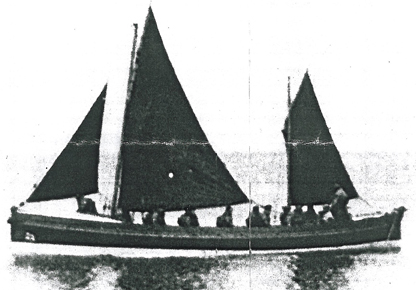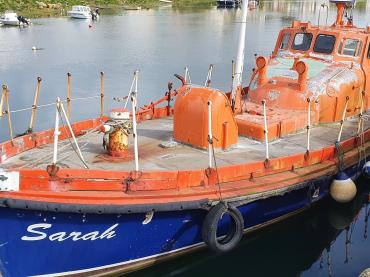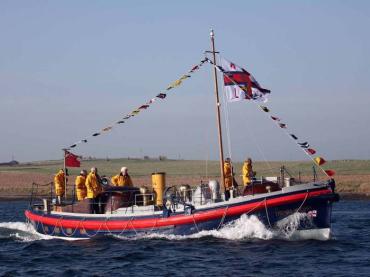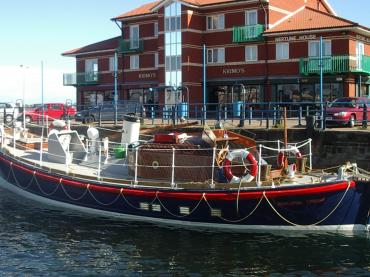


Details
Construction
Dimensions
History
CHARLES HENRY ASHLEY is a Watson Pulling and Sailing Class Lifeboat and was built in 1907 by Thames Ironworks, London and was in service from 1907 to 1932 at Cemaes, Anglesey, before being sold and left in storage until the 1960s. She was then motorised and used for 15 years, but was later abandoned until the 1980s when she was adopted by Amlwch Heritage Trust to no avail.
During the First World War the Cemaes Bay lifeboat CHARLES HENRY ASHLEY went to assist at an incident on 16 December 1914. She was manned for the 3 hours between 4.30 and 7.30pm to go to the assistance of the steam trawler ANGLIA of London. No other service was reported between 1914 and 1918.
Cemaes Bay is at the northern tip of Anglesey, where vessels travelling between Dublin and Liverpool passed close to its shores. The CHARLES HENRY ASHLEY was built by Thames Ironworks in 1907. She was stationed at the Porth yr Ogof lifeboat station by Wylfa Head near Cemeas Bay between 1907 and 1932, when she was retired from service because she was a non-self-righting lifeboat. CHARLES HENRY ASHLEY was the fifth lifeboat to be stationed at Cemeas Bay.
In her 25 years of active service she was launched a total of seven times, only one of which was during the First World War, and she was not credited with saving any lives. This was not because the coast around Anglesey was any less dangerous than other areas-indeed it was extremely hazardous; the reason for her limited activity was that the Cemeas Bay lifeboat played a secondary supporting role to other lifeboats stationed on Anglesey, and particularly to those stationed at Holyhead.
The hazards of the sea around Anglesey meant that the island was extremely well served with lifeboats. Holyhead had one of the earliest lifeboat stations in the country, having been established in 1828. In 1897 the station was provided with the first of the six steam lifeboats which served in the RNLI’s fleet between 1890 and 1928. The boat, the DUKE OF NORTHUMBERLAND, had first been stationed at Harwich in 1890, but remained at Holyhead until she was sold out of service in 1922. She was replaced by another steam lifeboat, the JAMES STEVENS No. 3, which remained there until 1928. Between 1915 and 1929 the Holyhead No.2 lifeboat station was home to the smaller self-righting lifeboat, the FANNY HARRIET.
Another lifeboat station was established by the Anglesey Association for the Preservation of Life from Shipwreck in Cemlyn, also in 1828. It was adopted by the RNLI in 1882, and housed the 35ft self-righting SIR JOHN between 1914 and 1919. Yet another was established at Rhoscolyn in 1830; between 1899 and 1929 this lifeboat station housed the 37ft RAMON CABRERA self-righting lifeboat. Others followed at Penmon in 1832, Llanddwyn in 1840 and Moelfre in 1848. The CHRISTOPHER BROWN served at Penmon between 1896 and 1915, and the 40ft CHARLES AND ELIZA LAURA served at Moelfre between 1910 and 1929, being launched a total of 35 times and saving some 84 lives.
A further round of lifeboat station building on Anglesey began in the 1860s. A station was built at Bull Bay in 1868; between 1904 and 1926 it housed the 38ft JAMES CULLEN. Further stations were built at both Cemeas Bay and Rhosneigr in 1872. The 34ft self-righting THOMAS LINGHAM was housed there between 1904 and 1924.
Two further lifeboat stations were built on Anglesey in 1891, those at Beaumaris and Porth Rhuffydd. The 43ft FREDERICK KITCHEN was based at Beaumaris between 1914 and 1945, but the Porth Rhuffydd lifeboat, the NORBURY, served only between 1891 and 1904.
She eventually returned to Cemaes, her original home port, where she has been totally refurbished and is now used for training.
Update, June 2024: Following a condition survey, it was discovered that there are some significant areas of decay in the vessel's structure that are too difficult to access, and would be far too costly to repair. Cemaes Boat Club has therefore made the decision that, for safety reasons, CHARLES HENRY ASHLEY must be ‘retired’ from her sea-going days, so will not return to her mooring in Cemaes Harbour. The Boat Club has now decided to concentrate all fund-raising towards preserving Charles Henry Ashley for the future and will pursue the aim of creating a suitable location where she can be stored for visitors to enjoy her history. She is a real asset for the Cemaes community and needs to be fully appreciated as a visitor attraction. In the meantime, maintenance work will continue on the first Saturday of every month and visitors are always welcome to come along to view her by arrangement.
Click here to see video footage of the vessel sailing out of Cemaes Bay.
Significance
1. What is the vessel’s ability to demonstrate history in her physical fabric?
Evidence for designs, functions, techniques, processes, styles, customs and habits or uses and associations in relation to events and people. How early, intact or rare these features are may impact on significance.
CHARLES HENRY ASHLEY (RNLI Official Number 583) is a standard 38 foot Watson Class Pulling and Sailing Lifeboat built in 1907. She is a monohull constructed in wood, using cross-diagonal planking with a double ended stern, and a single centreboard. She has an iron keel along with two drop keels, and is steered by means of a retractable rudder. She was motorised in the 1960s, but has now been returned to her original unpowered state. In 2006 much rotten wood was found within the hull, affecting good timbers, although her original hull was basically sound. The vessel was extensively refurbished between 2007 and 2008 with Heritage Lottery funding. Weak and damaged planking on hull and end-boxes, sections of keel, gunwhales and stern posts were replaced. She retains her original cross diagonal planking and centreboard. The hull has been sheathed in glass fibre sheet and impregnated with resin. The keel iron was removed, de-rusted and replaced. The rudder has had two stainless steel strengthening plates fitted. Her cork and ash belting was also replaced and her blue and white oars repainted. She is rigged with a jib, a dipping lug mainsail and a dipping lug on the mizzen mast, and fitted with twelve rowlocks, six on each side.
2. What are the vessel’s associational links for which there is no physical evidence?
Associations with people or places. Off-ship research.
CHARLES HENRY ASHLEY was built by Thames Ironworks and Shipbuilding Company, Blackwall and designed by G L Watson. She was the thirty-eighth of forty-two standard Watson Class Pulling and Sailing Lifeboats to be built and was in service from 1907 to 1932 at Cemaes, Anglesey, giving her local associations to this area. During that time she was launched on service seven times, but she is not credited with saving any lives. She saw only very local service; around a dozen lifeboats were in service in Anglesey at the time, and there was a large lifeboat station nearby at Holyhead. Detailed plans for this type of vessel survive at the National Maritime Museum. There are also early paintings of her, records including the names of her crew whilst in service and a number of photographs. She has been recorded on the National Register of Historic Vessels since 2009.
3. How does the vessel’s shape or form combine and contribute to her function?
Overall aesthetic impact of the vessel, her lines, material she was built from and her setting. Does she remain in her working environment?
CHARLES HENRY ASHLEY is open-decked, carries two masts, fore and aft, and is Bermudian rigged. Her hull is built from Honduras mahogany. As a standard Watson Pulling and Sailing Class Lifeboat she was purpose-built, with her design was well suited to the waters where she would operate. As an operational vessel returned to her original configuration she has graceful lines when in full sail. She is now fully operational again and used for training in her original home port of Cemaes where she served for 25 years.
Source: NHS-UK team, 02 November 2016.
This statement was developed as part of the Heritage Lottery funded First World War project. http://www.ww1britainssurvivingvessels.org.uk/
Key dates
-
1907
Built by Thames Ironworks as a lifeboat
-
1960s
Vessel motorised
-
1980s
Abandoned but later refurbished and used for traiining
Grants
-
2007/08
The Heritage Lottery Fund awarded £41,600 for developing the main application for restoration, conservation and development
Own this vessel?
If you are the owner of this vessel and would like to provide more details or updated information, please contact info@nationalhistoricships.org.uk



